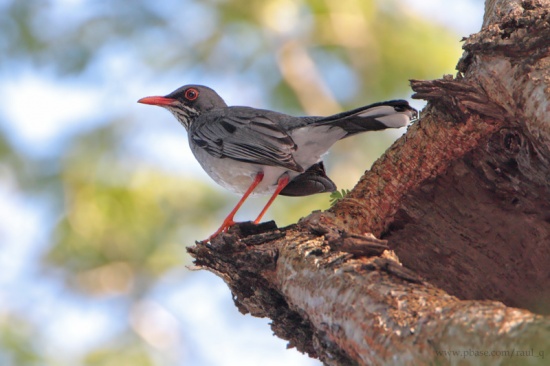(taxon, refs) |
|||
| Line 14: | Line 14: | ||
:*North [[Bahamas]] | :*North [[Bahamas]] | ||
*''T. p. schistaceus'': | *''T. p. schistaceus'': | ||
| − | :* | + | :*Eastern [[Cuba]] (Holguín, Santiago de Cuba and Guantánamo provinces) |
*''T. p. rubripes'': | *''T. p. rubripes'': | ||
| − | :*Central and western Cuba and Isle of Pines; formerly Swan Island | + | :*Central and western Cuba (east to western Holguín Province) and Isle of Pines; formerly Swan Island (east of [[Honduras]]) |
*''T. p. coryi'': | *''T. p. coryi'': | ||
:*Cayman Brac ([[Greater Antilles]]) | :*Cayman Brac ([[Greater Antilles]]) | ||
| Line 34: | Line 34: | ||
Song is described as similar to [[La Selle Thrush]]; however, Red-legged Thrush should regularly include a sharp pit or wit sound missing in song of La Selle Thrush. | Song is described as similar to [[La Selle Thrush]]; however, Red-legged Thrush should regularly include a sharp pit or wit sound missing in song of La Selle Thrush. | ||
==References== | ==References== | ||
| − | #{{Ref- | + | #{{Ref-Clements6thAug21}}#C Vaurie (1957) FIELD NOTES ON SOME CUBAN BIRDS. [http://elibrary.unm.edu/sora/Wilson/v069n04/p0301-p0313.pdf The Wilson Bull. 69:301-313.] |
#DW Johnston (1969) The thrushes of Grand Cayman Island, BWI. [http://elibrary.unm.edu/sora/Condor/files/issues/v071n02/p0120-p0128.pdf The Condor 71:120-128.] | #DW Johnston (1969) The thrushes of Grand Cayman Island, BWI. [http://elibrary.unm.edu/sora/Condor/files/issues/v071n02/p0120-p0128.pdf The Condor 71:120-128.] | ||
#Clement and Hathway (with C. Byers, J. Wilczur). 2000. The Thrushes (Helm Identification Guides). Christopher Helm Publishers Ltd. London. ISBN 978-0713639407 | #Clement and Hathway (with C. Byers, J. Wilczur). 2000. The Thrushes (Helm Identification Guides). Christopher Helm Publishers Ltd. London. ISBN 978-0713639407 | ||
Revision as of 01:11, 29 September 2022
- Turdus plumbeus
Identification
Generally has slate gray upperparts, red legs and bill, red eye-ring, and white corners of the tail; the tail is long and rounded or graduated. Underside is variable with some subspecies showing reddish-brown abdomen, others showing white, and others again showing gray. Throat is also variable, black, gray or white with black stripes; there seems to always be some white somewhere around the throat or chin. At least in Dominica, white outer tail feathers are visible in flight (not mentioned in field guides).
Distribution
This bird has a disjunct distribution with one population in Dominica (Lesser Antilles) and another in the Greater Antilles including Northern Bahamas, Cuba, Cayman Brac in Cayman Islands, Hispaniola, and Puerto Rico.
Taxonomy
This species has previously been considered to belong to a different genus and therefore had the scientific name Mimocichla plumbea; Johnston (1969) argued for this treatment. DNA results support this species belonging within the Turdus thrushes, unless these are to be split into several genera.
Subspecies
In total, there are six subspecies recognised by Clements[1], with some distinct differences in plumage. It would seem prudent to do more research on the taxonomic status of these taxons.
- T. p. plumbeus:
- North Bahamas
- T. p. schistaceus:
- Eastern Cuba (Holguín, Santiago de Cuba and Guantánamo provinces)
- T. p. rubripes:
- Central and western Cuba (east to western Holguín Province) and Isle of Pines; formerly Swan Island (east of Honduras)
- T. p. coryi:
- Cayman Brac (Greater Antilles)
- T. p. ardosiaceus:
- Hispaniola, Puerto Rico, Gonâve Island and Tortue Island
- T. p. albiventris:
A seventh taxon is most often treated as a separate species, the Grand Cayman Thrush, which became extinct between 1916 and the 1960ties.
Habitat
In e.g., Puerto Rico seems to prefer the higher elevation, wetter forests, while on e.g., Dominica it likes the lower elevation dryer scrub-forest.
Behaviour
As described by Vaurie (1957), at least the subspecies rubripes in Cuba shows some behavior patterns that would be more typical of thrashers than most Turdus thrushes, including holding the tail kinked upwards when alert, and looking similar to a large catbird when moving around on the ground or through undergrowth.
Breeding
The male, when trying to impress the female, will flash his wings in a short display similar to what is seen in Northern Mockingbird. ====Vocalisation Song is described as similar to La Selle Thrush; however, Red-legged Thrush should regularly include a sharp pit or wit sound missing in song of La Selle Thrush.
References
- Clements, J. F., T. S. Schulenberg, M. J. Iliff, S. M. Billerman, T. A. Fredericks, J. A. Gerbracht, D. Lepage, B. L. Sullivan, and C. L. Wood. 2021. The eBird/Clements checklist of Birds of the World: v2021. Downloaded from https://www.birds.cornell.edu/clementschecklist/download/
- C Vaurie (1957) FIELD NOTES ON SOME CUBAN BIRDS. The Wilson Bull. 69:301-313.
- DW Johnston (1969) The thrushes of Grand Cayman Island, BWI. The Condor 71:120-128.
- Clement and Hathway (with C. Byers, J. Wilczur). 2000. The Thrushes (Helm Identification Guides). Christopher Helm Publishers Ltd. London. ISBN 978-0713639407
- Larsen, N. (2020). Red-legged Thrush (Turdus plumbeus), version 1.0. In Birds of the World (T. S. Schulenberg, Editor). Cornell Lab of Ornithology, Ithaca, NY, USA. https://doi.org/10.2173/bow.relthr1.01
Recommended Citation
- BirdForum Opus contributors. (2025) Red-legged Thrush. In: BirdForum, the forum for wild birds and birding. Retrieved 15 January 2025 from https://www.birdforum.net/opus/Red-legged_Thrush






